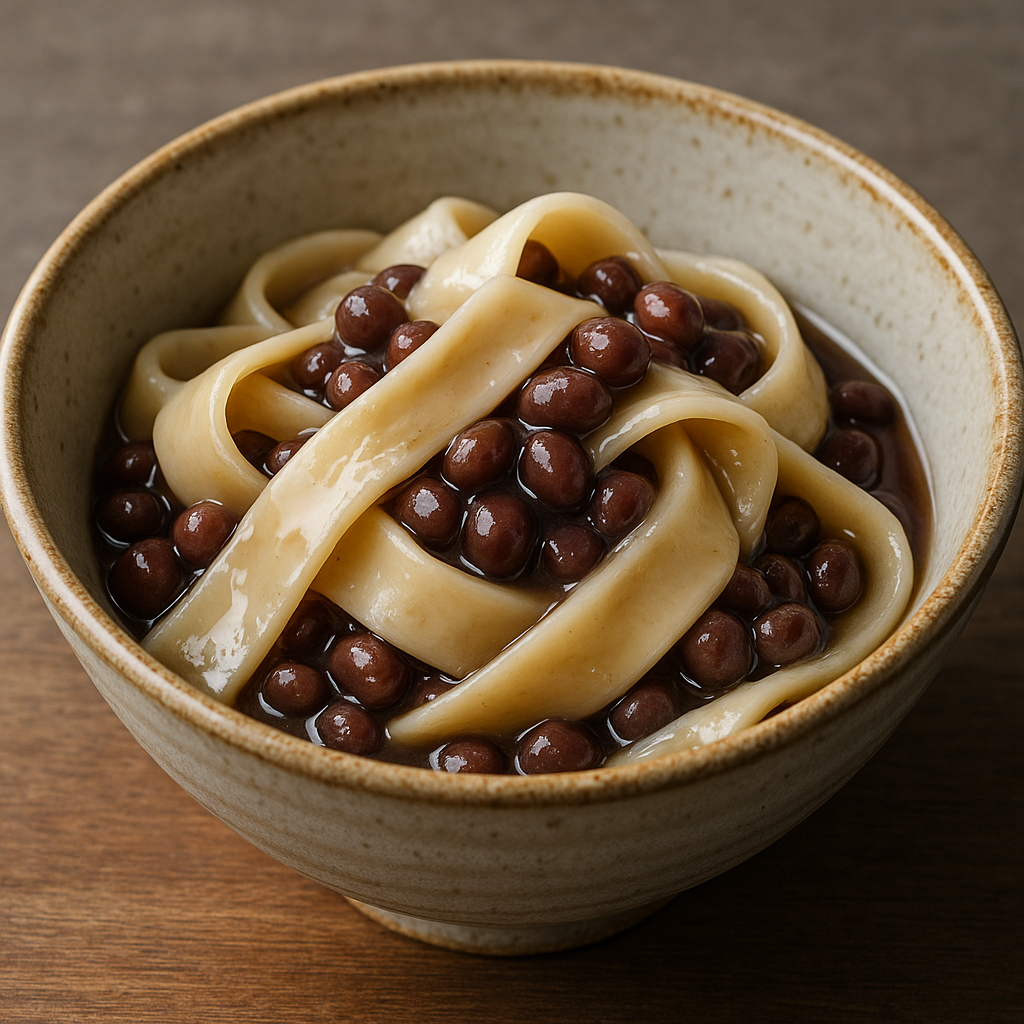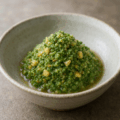小豆ばっとう(岩手)の特徴
うどんを甘い小豆汁で煮る、素朴な郷土菓子
小豆ばっとうは幅広で短めのうどんをやわらかく煮た小豆の甘い汁で煮含める岩手の甘味です。もちもちとした口当たりと、小豆のやさしい甘さが身体に染みわたります。
冬の“おやつ”や行事にも親しまれてきました
寒い季節の腹持ちのよいおやつとして、また行事のふるまいとしても作られてきました。うどんや小豆の甘さ加減は家庭ごとの“我が家の味”が受け継がれています。
小豆ばっとう(岩手) レシピ
材料(5人分)
- 小豆(乾) … 200g
- 水(小豆煮用) … 900〜1,100ml
- 砂糖 … 120〜160g(好みで加減)
- 塩 … ひとつまみ(味の締め)
- うどん…500g
- (好みで)きなこ … 適量/黒蜜 … 適量
作り方
- 1. 小豆は洗い、たっぷりの水で一度ゆでこぼす。新しい水を加えて弱めの中火でやわらかくなるまで煮る。
- 2. 砂糖と塩ひとつまみで調味し、軽くとろみが出るまで10〜15分ほど静かに煮る。
- 3. うどんを茹でて、少し芯が残るぐらいになったら小豆汁で煮る。
- 4. 味を見て砂糖や塩で調整する。器に盛り、好みできなこや黒蜜を添える。
シェフのワンポイントアドバイス
- 既製品のあんこと乾麺のうどんを使えばお手軽に作ることが出来ます。
栄養価(1人分の目安)
- エネルギー … 280〜380 kcal
- たんぱく質 … 8〜12 g
- 脂質 … 1〜4 g
- 炭水化物 … 55〜70 g
- 食物繊維 … 5〜8 g(小豆由来)
歴史
小麦生地“ばっとう/はっと”の甘味仕立てです
岩手各地で食べられてきた小豆の甘い汁にうどんを入れ、おやつに仕立てた一品です。粉と豆で腹持ちがよく、寒い季節の滋味として親しまれてきました。
家庭ごとの厚みと甘さが“我が家の味”を作りました
小豆の甘さ加減は家ごとに工夫があり、祝いの席や子どものおやつとして受け継がれています。きなこや黒蜜を添える食べ方も各家庭で楽しまれています。
English Version
Features of Azuki Batto (Iwate)
Simple comfort: udon gently simmered in sweet azuki broth
Azuki batto is a homey sweet dish from Iwate: wide, short udon noodles are simmered in a lightly thickened, sweet azuki bean broth. The chewy bite of the noodles and the gentle sweetness of beans make a soothing bowl.
A winter snack and festive treat
It has long been enjoyed in cold seasons as a filling snack and for gatherings. Noodle width and sweetness vary by household, forming each family’s cherished style.
Azuki Batto (Iwate) – Recipe
Ingredients (Serves 5)
- Dried azuki beans … 200 g
- Water (for cooking azuki) … 900–1,100 ml
- Sugar … 120–160 g (to taste)
- Salt … a pinch (to round flavor)
- Udon noodles … 500 g
- (Optional) Kinako … as needed / Kuromitsu … as needed
Directions
- 1. Rinse azuki; bring to a boil once and drain (quick parboil). Add fresh water and simmer gently until tender.
- 2. Season with sugar and a pinch of salt; simmer 10–15 minutes more until lightly thickened.
- 3. Boil udon separately until slightly undercooked; transfer to the azuki broth and simmer to finish.
- 4. Taste and adjust with sugar or salt. Serve in bowls; offer kinako or kuromitsu if you like.
Chef’s Tips
- Using store-bought sweet red bean paste (anko) and dried udon makes a quick version.
- Cook udon a touch firm and finish in the azuki broth so noodles absorb flavor without softening too much.
- A tiny pinch of salt at the end sharpens sweetness and rounds the taste.
Nutrition (per serving, approx.)
- Energy … 280–380 kcal
- Protein … 8–12 g
- Fat … 1–4 g
- Carbohydrates … 55–70 g
- Dietary fiber … 5–8 g (from azuki)
History
A sweet spin on wheat “batto/hatto”
Across Iwate, the wheat-based “batto” tradition meets sweet azuki broth to create a warming snack. Beans and flour together offer hearty comfort in winter.
Household variations endure
Sweetness and noodle style differ by home, with some families finishing with kinako or a drizzle of kuromitsu—small touches that define their own taste.



何でも質問してください!